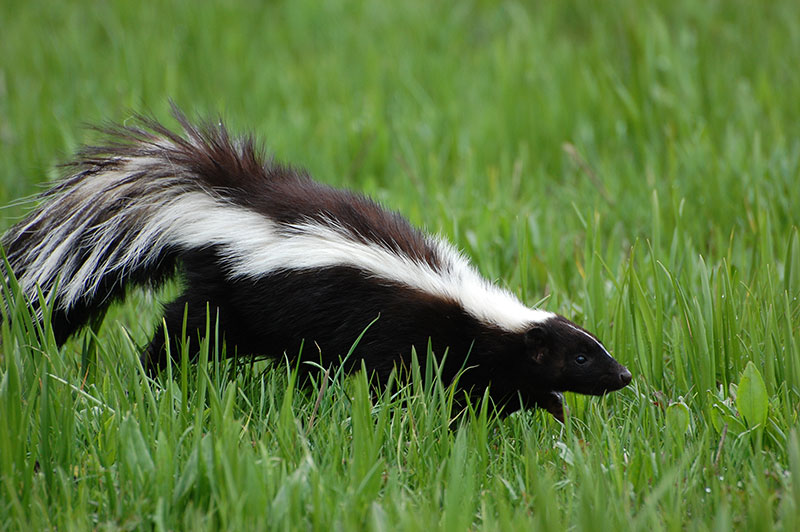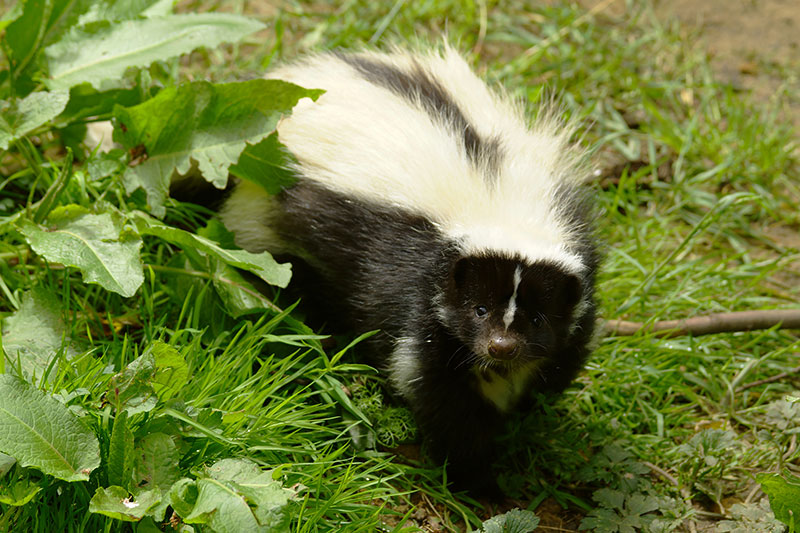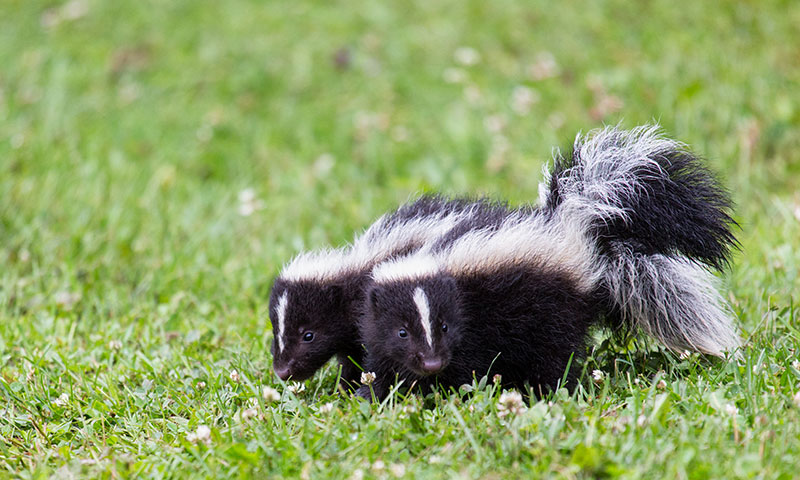
 WildlifeNYC311
WildlifeNYC311 Search all NYC.gov websites
Search all NYC.gov websites
Striped Skunks
Striped Skunk (Mephitis mephitis)

Introduction
"Looks can be deceiving." The saying applies as much to New Yorkers as it does to the city's wildlife. Take striped skunks (Mephitis mephitis) for example. From afar, their sleek black and white fur and bushy tail make them seem like cute, defenseless members of our local ecosystem. But get too close, and they'll release a spray that will help you understand why their scientific name is Latin for "double foul odor."
Unfortunately, their foul-smelling defense mechanism has not been enough to protect them from habitat loss and overtrapping. High demand for their pelts in the 1930s and 1940s impacted their populations, and human development has resulted in fewer open, natural areas that skunks prefer to inhabit. However, though they are relatively rare within New York City, they have been spotted throughout the boroughs in recent years.

General Information
Background
Striped skunks can live in a variety of habitats, but they generally avoid forested areas and prefer to live near open spaces. In New York City, open lots and grassy areas in parks provide ideal habitat. Skunks will oftentimes den in burrows created by other animals like woodchucks. They will also den under buildings and inside hollow logs. In winter they retreat to these dens and tend to be less active. However, they do not hibernate.
Skunks are opportunistic feeders that adapt their diets based on the season. In spring and summer they will feed primarily on insects. In winter months their diet can include small mammals and birds as well. They are also known to feed on vegetation, nuts, amphibians, reptiles, and fish.
Skunks are vulnerable to a number of parasites and wildlife diseases, and can carry and transmit rabies. In fact, other than raccoons, skunks are the species most likely to carry rabies in New York. However, in NYC, only a few confirmed cases occur in skunks each year. In the wild, skunks usually live for up to seven years.
Appearance
Skunks have a distinct coat of black and white fur that makes them easily identifiable. Their underside is black. Their white fur begins at the top of their heads and runs back along the top and sides of their bodies, usually in a v-shaped pattern. A strip of white fur is also found between their eyes. Their tails are bushy, with a mix of black and white fur.
Their size can fluctuate based on the time of year and where they are located. They can lose up to 50% of their body weight during the winter. Typically they are about the size of a house cat, ranging from 22 to 32 inches long and weighing roughly 10 pounds.
Behavior
Mating season for striped skunks runs from February to March. In May, females give birth to an average of six kits in their burrows. It takes kits about three weeks for their eyes to open, and up to seven weeks for them to be able to find their own food. Young skunks will typically follow their mother around in a single file line as they learn to forage and hunt for themselves.
Skunks’ well-known defense mechanism is a fluid that they spray from glands located near the base of their tail. In addition to smelling bad, this spray can temporarily blind and cause pain if it enters the eyes of its target. The spray can also travel as far as 10 feet.

Fast Facts
- Skunks were at one time considered members of the weasel family, but are now classified in their own family: Mephitidae.
- Skunks will often issue warnings before using their spray, including stomping, hissing, and arching their back.
- The smell from their spray can linger for days, and features a chemical that renders it mostly waterproof. Click here for tips on removing skunk spray from pets and clothing.
Tips for Coexistence
- Skunks can be seen day or night. They are nocturnal, and often come out late at night or at dawn to forage. However, in urban environments, where there is plenty of food and few predators, they can be spotted looking for meals during the day. This does not mean they are sick.
- Store all food and garbage in animal-proof containers. Trash and pet food are attractive meal options for urban skunks. Make sure pet food is not left unattended, and garbage bins are firmly secured.
- Observe and appreciate skunks from a distance. Skunks will spray humans or pets that they perceive as a threat. For your safety and the safety of the animal, always observe skunks from a distance.
- Protect and vaccinate your pets. Skunks can carry and transmit rabies, as well as many other parasites and wildlife diseases. Walking dogs on a leash and keeping cats inside is best for the safety of both skunks and pets. Also be sure to keep your pets’ vaccinations up to date. It’s the law.


